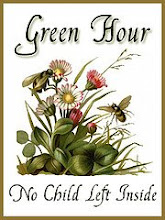 photocredit:Chantelle
photocredit:ChantelleAlas I'm not much of a musician myself ... given a choice, I will listen to National Radio rather than a music station ... and faced with an array of musical instruments I just freeze. This makes doing music with kids a little bit intimidating.
"Get to know the (musical) equipment well yourself. Try out all the instruments and find what different sounds you can make. Be alert for spontaneous music play ...' Maureen Woodhams, Making Music With Children.
Playcentre, Montessori and Steiner/Waldorf all have very different approaches to musical education for preschoolers ... and given my own dunce status I hesitate to assume any authority here. So, as always, comments and debate always welcome!
 photocredit:anonymous
photocredit:anonymous"Become attentive to what the children are doing musically, both in focused music sessions and in their general play. This may involve stopping being active yourself so you can spend a few minutes just watching and listening. Children often chant or sing a pattern of words or a snatch of tune, especially during solitary play... musical interactions, like conversation, often occur while adults and children are doing something else together and are a joy when you start to notice and extend them." Maureen Woodhams
Playcentre
In a Playcentre, the 'music area' will usually be well resourced with a range of musical instruments - shakers, tambourines, drums, ukuleles, perhaps an old piano. There will usually be a CD player and a collection of recorded kids music ... which will often play loudly during the session.
Adults are encouraged to recognise when children show an interest in the music area, and play along side them, exploring the different instruments, dancing and singing.
"The provision of an attractive display of musical instruments and objects ensures that children have independent access to some music experiences whenever they choose. It also ensures that when a play interaction takes a musical turn, or an adult sees a way to extend a child's learning following a music interest, some materials which might support this are directly to hand. Maureen Woodhams
Steiner/Waldorf
As in all areas of play, Waldorf education is concerned with protecting and nurturing the senses, so in this instance it’s the sense of hearing. As children's hearing develops, they need first of all to hear real, living, human sounds - voices of course, and clapping rhythms are often considered very appropriate. The pentatonic scale is recommended for the early years -this has five pitches per octave and sounds lighter and more 'floaty' somehow.
You won't see many, if any, musical instruments in a Steiner/Waldorf kindergarten. Carrie was very kind to share some excerpts from 'In a Nutshell' with me that explain why.
"Because we prefer to offer the children open-ended play materials- that is, materials which can be used in many different ways, according to the child's needs of the moment - we also do not provide many of the traditional rhythm toys. However, some teachers do have bells, gourds or perhaps a drum or pentatonic xylophone available in the classroom.....It is important that these instruments produce a good quality sound, and in the case of the xylophone, that the notes are in tune. The children may play freely with these instruments, as long as they treat them with appropriate care and the sounds do not become disruptive to the mood of the classroom" Nancy Foster, In a Nutshell
You might say that if Steiner/Waldorf is concerned with protecting the senses, Montessori is concerned with perfecting them. I think no where is this more obvious than with music.
In the Montessori 3-6 programme, children are given materials to encourage them to listen carefully and learn to differentiate not only different sounds, but different pitches too. Games such as sorting objects by sound, recognising pitch using glasses of water, or the Montessori bells encourage this precision.
Making a joyful noise
 photocredit:Melissa
photocredit:MelissaOf course, what these three very different approaches have in common is seeking to encourage and develop a sense of musical appreciation in our children (so they can be groupies too!). I love the idea of teaching listening skills in Montessori, I love that the Steiner approach doesn't abuse a child's ears with tinny poppy kiddy music, and I love that Playcentre lets kids really have fun and enjoy music in all its wonderful guises. After all, banging pots and pans in the kitchen is as much a music lesson as anything else! Children love and deserve the opportunity to listen to live music where possible, and to experiment with making their own music too.
So, a few fun ideas for bringing music into your pre-schoolers home!
- sing all the time. Have special songs for special times of the day, and lots of songs just because. Don't worry that you can't sing in tune, honestly, your child won't mind!
- make lots of 'ad hoc' instruments. Bang pots, put small objects in glass jars (with supervision), fill glasses with water and tap them with spoons.
- play silence games ... encourage your children to listen to the quieter sounds around them.
- take your children to see live music - buskers, brass bands, folk bands playing at the markets ... start asking about where you might be able to find real instruments being played
Enjoy!

photocredit:Rodent







7 comments:
Thank you for this great post as music is also what I am finding most difficult to approach with toddlers!
I should have loads to say about this- I have a music degree and am a Montessori teacher. However, I think each aproach has a lot to say for it. In the end we want our children to feel that music belongs to them, rather than being something that you can only do if you are an expert. That can be an attiutde that even very young children pick up.
My pet hate is children being allowed to bang loudly and aimlessly on things. I support the Steiner approach of keeping thngs simple and natural. I play lots of singing games and games with finger play and songs. When children are a little older (3 maybe) it is lovely to be able to lead them in responding to different music. While a real instrument is good, well chosen recordings are a good substitute, especialy of the adult is playing along with the children. They then have a model to learn from.
The Montessori model of using many of the materials to teach listening and discrimination is wonderful. As an addition we have a set of pentatonic chilme bars which get good use and always sound gorgeous. I teach class music using the Kodaly method which is simple, uses singing and body percussion and builds in a very Montessorian fashion from simple to more complex.
The final thing is - take music outside. At nursery there is a music wall set up with all sorts of objects, to be banged, tapped and played. The children love it!
Excellent post Gypsy! As a board certified music therapist, I feel you did not only a lovely job explaining what each view supports, but you also emphasized the "appreciation" and play based nature that music should be at this age. (As opposed to teaching a very young child music notes and such).
Lovely post. The more I read your area of play posts the more I see how I'm leaning toward Steiner; albeit from a playcentre base. At our centre we actually discourage the use of the CD player on session unless it's requested by the children or being used for a specific purpose, it's so distracting to have blaring in the background. We have a music focus session coming up, using bonging pots and water in jars etc. so I will refer back to this to focus my ideas before then I think. Thanks for another great post!
I enjoyed this post discussing the different approaches.
I think I'd like to work on taking my children to see live instrumental music, that is something that I've never consciously done.
I have noticed how much my oldest loves to sing and dance. It spontaneously happens during play. In the car we listen to the "Music Together" cds I find they are pleasurable to listen to and like the fact that they are multicultural. One question: I was once told that Waldorf teachers sing sometimes instead of talking (like when giving directions or transitioning) because the children will respond better/naturally to it. Is this true?
Thanks for all your comments. Amy - yes, Waldorf kindy teachers will sing a lot, and aim to speak very little. The reason for this is to create a sense of rythm that carries the children through the morning from task to task, rather than breaking that rhythm with talking and direction. Also, singing 'children come and wash your hands, wash your hands, wash your hands' is felt to call less on their 'dream consciousness' than a direct order to clean hands. You really need to see it to understand it ... it does work amazingly well.
Post a Comment